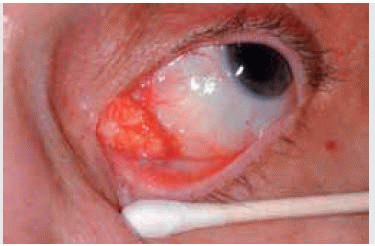 Caruncular Tumors
Caruncular TumorsCaruncular Tumors
General Considerations
The caruncle lies at the inner canthus nasal to the plica semilunaris. It has a nonkeratinizing epithelial lining similar to conjunctival epithelium. However, the caruncle harbors cutaneous elements such as hair follicles, sebaceous glands, sweat glands, and accessory lacrimal gland. Consequently, the caruncle can spawn a tumor or cyst that may be similar to one found in the skin, conjunctiva, or lacrimal gland (1,2,3,4,5,6,7,8,9,10,11,12,13,14,15,16,17,18,19,20,21,22,23,24,25,26,27,28,29,30,31,32).
Approximately 95% of caruncular lesions that are suspicious enough to warrant surgical excision prove to be benign, with the majority being either papilloma or melanocytic nevus. Only 5% of biopsied tumors of the caruncle are malignant (4,5). In our series of 57 excised caruncular tumors reported in 1986, a breakdown of lesions is as follows: papilloma 32%, melanocytic nevus 24%, pyogenic granuloma 9%, inclusions cyst 7%, chronic inflammation 7%, and oncocytoma 4% (4).
Clinical Features
Clinically, a caruncular tumor presents as an enlargement of the caruncle as a distinct mass arising from or displacing the caruncle. The clinical appearance varies with the type of tumor. Papilloma generally appears as a frondlike mass with fine vascular tufts visible clinically in the central core of each frond (1,4,7). Caruncular nevus usually appears at about puberty, is variably pigmented, and may show slight change in size or color with time. It generally contains clear cysts best seen with slit-lamp biomicroscopy (1,4,8). Caruncular melanoma appears as a variably pigmented, usually noncystic, solid mass.
Oncocytoma is a benign tumor that is believed to originate from transformed glandular epithelial cells, particularly in the lacrimal gland, salivary glands, and other organs. When it occurs in the caruncle, it appears as an asymptomatic, slowly growing, reddish blue solid or cystic mass. It most often occurs in older individuals.
Several sebaceous gland tumors and cysts can arise from the caruncle. Sebaceous gland hyperplasia and sebaceous adenoma may resemble each other clinically, appearing as a smooth or multinodular yellow mass. Sebaceous gland carcinoma in the ocular area usually arises from the sebaceous gland of the tarsus (meibomian glands) or cilia (Zeis glands), but they can arise from the sebaceous gland of the caruncle (14,15). Sebaceous gland carcinoma can be aggressive and can metastasize.
Stay updated, free articles. Join our Telegram channel

Full access? Get Clinical Tree


